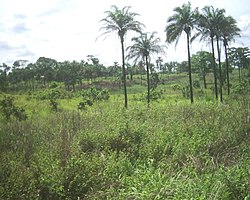

The wildlife of the Democratic Republic of the Congo includes its flora and fauna, comprising a large biodiversity in rainforests, seasonally flooded forests and grasslands.
Contents
The country is considered one of the 17 megadiverse nations, and is one of the most flora rich countries on the African continent. [1] Its rainforests harbour many rare and endemic species, such as the chimpanzee and the bonobo. It is home for more than 10,000 types of plants, 600 timber species, as well as 1,000 bird species, 280 reptile species, and 400 mammal species, including the forest elephant, gorilla, forest buffalo, bongo, and okapi. Many of these wildlife species are threatened animals such as large lowland gorillas and chimpanzees. [2]
Five of the country's national parks are listed as World Heritage Sites: the Garumba, Kahuzi-Biega, Salonga and Virunga National Parks, and Okapi Wildlife Reserve. All five sites are listed by UNESCO as World Heritage In Danger.
Several environmental issues in the DRC threaten wildlife, including overhunting for bushmeat, deforestation, mining and armed conflict. The civil war and resultant poor economic conditions have endangered much of the country's biodiversity. Many park wardens were either killed or could not afford to continue their work.

